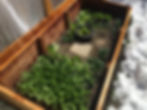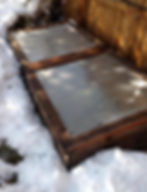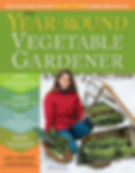Year-Round Gardening in Colorado
- Idelle Fisher
- Apr 4, 2024
- 7 min read
Updated: Mar 24, 2025
Year-Round Vegetable Gardening in Colorado is Possible with a Cold Frame or Hoop House
By Idelle Fisher:


Cold Frames are basically a small, short version of a greenhouse – more or less a raised bed with sloped lids that trap solar heat to keep the bed warm. Sometimes called “Dutch Lights,” cold frames are a much less expensive alternative to greenhouses for growing in winter months and some say they are even more effective for growing winter greens or hardening off seedlings in the spring without added heat.
Cold Frames don’t take up any more room than a standard vegetable bed and you can build them easily yourself. You can use old skylights, windows, glass doors, etc, but polycarbonate plastic paneling is stronger and won’t shatter into your bed during a hailstorm.

In a Denver Urban Gardens class (dug.org) I learned about building cold-frames and about a great book, The Year-Round Vegetable Gardener: How to Grow Your Own Food 365 Days a Year, No Matter Where You Live, by Niki Jabbour. It’s packed with information including a handy diagram for building a cold frame.
With my Dad’s woodworking expertise, tools, and his and my sister’s help, we built three cold frames a couple years ago, one for each of us. My dad’s and sister’s were smaller, using the scraps of plastic for “window panes.” (Dad’s idea… genius!) I purchased 6mm polycarbonate sheets (at Colorado Plastic Products in Louisville - coloradoplastics.com) which provide insulation and heavy-duty protection. I like the idea of recycling old windows or glass shower doors, but the thought of picking out broken glass from a hail-pummeled garden bed was a disincentive, though some with stronger/thicker glass may be better than others.

Auto-Vents are Crucial for Cold Frame Vegetable Health
Due to the shade of the house and a nearby evergreen tree I didn’t think 3-5 hours of sun would be enough, but it actually got quite hot in the cold frame on sunny winter days. In fact, if I didn’t open the lids, my cool weather-loving vegetables would cook as temps inside can easily and quickly climb past 100˚ F on warm sunny winter days. I bought a Univent brand vent from acfgreenhouses.com with a wax-powered piston that expands as it warms up, opening the cold frame, and closing it when it cools down – no electricity required. Cool-weather greens and veggies don’t like super hot temperatures, so venting is essential all winter long.


No Heat Needed!
It’s hard to believe, but with a little cover, cool-weather veggies thrive even during freezing temperatures. The added wind protection and warmer soil helps keep cold-weather veggies alive. They don’t grow fast in the short, cold days of winter, but with the cold frame lids closed they stay alive without added heat or insulation and then really start to take off in March and April.
Don’t forget to brush the snow off cold frames during the day so they can gain solar heat! I use a broom.
Watering
I water my cold frame during the spring, fall and winter months, but not that often. If we have a couple weeks of sunny, warmer weather I may water every one to two weeks, but when it’s cold I usually don’t water at all. I typically open both lids on nice sunny days in the winter when it’s over 45-50˚ F. Fresh air and breezes help cut down on pests and mold/dampening off. I check the soil and if it starts drying out, I water well with a watering can.

Mulch
Leaves and twigs help insulate seedlings and plants, so I add a light layer throughout my bed in the winter which also feeds the soil and the worms. You’ll discover that the leaves “disappear” as the worms pull them down and munch on them leaving fertilizing worm castings as thanks. Don’t smother your seedlings with mulch, however, they can’t grow if they’re completely covered.

Growing Your Own Food Year-Round Reduces Plastic & Pollution
One way we can cut back on plastic and emissions is to grow our own food. Just think about it; when you buy vegetables at the grocery store, plastic is often part of the equation. Organic lettuces, brussels sprouts, cabbage, carrots, and celery, for example, usually come packaged in plastic containers or bags. With my cold frame for winter growing, I can pick fresh lettuce, cabbage, spinach, green onions, parsley, cilantro with no trip to the store or plastic packaging required.
Treating Wood Cold Frame with Stains or Oils
We used naturally pestand rot resistant cedar wood for the cold frames. However, I wish I had treated mine sooner as the wood started to dry and crack after one winter season. My sister and Dad treated theirs, and they also disassemble and store them in the summer months, so their wood looks a little nicer for sure! My husband and I first used boiled linseed oil, but found it to be really stinky for a couple weeks - not ideal for our vegetables, wildlife or us.
So, this year I used Vermont Natural Coatings semi-transparent PolyWhey® Exterior Penetrating Wood Stain in the color: Lakeside Cedar. This company uses whey proteins instead of toxic ingredients found in traditional wood finish. (Their products also have ultra-low VOC levels, and are free from carcinogens, mutagens, and reprotoxins that are still found in many products claiming to have low or no VOCs.) Their penetrating wood stain goes on easily, has a thin consistency that doesn’t gunk up your brush, and it hardly smells at all compared to other stains. It provided a nice waterproof finish for the summer. I also talked to a local greenhouse builder who uses beeswax to protect wood greenhouse frames. Throughout history beeswax has been used as a natural wood treatment and waterproofing sealant. Beekeepers sometimes protect their wood hives with a combination of beeswax, walnut oil, and ground wood charcoal, heating it to mix, then cooling to apply. I’ll have to try that someday!
I’d Build a Taller Cold Frame Next Time
If I build another cold frame, I will make it taller. Mine is about 14″ high in the back, shorter in the front and when veggies get growing they touch the inside of the closed lid. Some extra height would also be nice for storing summer vegetable seedlings during the hardening off period in May/June. Another solution is to dig down to make extra headroom.
You can build a wood-frame cold frame out of lots of things and you don’t have to be a carpenter. If you have access to bricks or wood beams, you could build a simple back wall, and then drape plastic or a window to create a warm protected area.

Hoop Houses Have More Headroom
Speaking of more headroom, another great way to grow year-round in Colorado is with a Hoop House. Hoop houses are great for winter growing, and though most have to be manually vented, they do provide more headroom for growing taller vegetables and storing seedlings and potted plants during cold spells or storms. I was lucky to get a hoop house from Earth Love Gardens in 2020, just as the pandemic was starting. This simple garden bed hoop house is made from metal conduit hoops and long-lasting Agtec Super Strength Clear Woven Greenhouse Film fabric (12mm) that should last 7+ years. Aaron designed the sidewalls to be held in place, with a large rolling panel that can be rolled up easily to vent the hoop house on sunny days. It’s very sturdy, withstands heavy snowstorms, hail, and wind very well, and it allows me to grow taller and potted plants in the winter. The greenhouse film is far superior to regular plastic for longevity and durability.

Native plants, peppers, and other veggies staying warm & protected in the hoop house in early stormy June last year
What can I plant in Colorado in April?
You can start lots of seeds directly in your cold frame bed or hoop house throughout the fall, winter and, of course, in early spring. April is a great time to sow seeds for lettuces, kale, spinach, mustard, cabbage, celery, onions and herbs like dill, cilantro and parsley. They will germinate and grow much more quickly than in uncovered outdoor garden beds (where row cover can help some, by increasing the temperature a few degrees) during our often freezing spring nights. Put Seedlings in Cold Frames or Hoop Houses in early Spring Hoop houses and cold frames are great for hardening off indoor-grown warm-season vegetable and flower seedlings, providing a protected space outside to acclimate them to outdoor weather until you transplant them into the garden. (If you have room indoors with bright light(s) you can keep these inside until nighttime temperatures are over 50-60˚- typically late May and early June in Denver.)
In April and early May, before moving some of my indoor-started seedlings out into my cold frame and hoop house I put out a “test subject” or two to see how they fare with cold nights. A spare basil plant is a good indicator since it wilts at the first chance of frost. I also test a pepper or tomato seedling for a few nights before moving more in. As long as it doesn’t drop well below freezing overnight, these hold up well, even with a few spring snowstorms. If a deep freeze is expected I bring them back into the house. I also start native plant seeds and keep them in my cold frame and hoop house over the winter to get them growing well before transplanting in spring.
Don’t forget to vent on sunny days, even if there is snow on the ground!
Another tip for Peppers and Tomatoes
When kept in the same small pot, tomato or pepper seedlings will not grow nearly as fast as those that are potted up into larger pots as they grow. Especially with tomatoes, remove the bottom leaves and bury the stems, leaving about 2-3″ of the plant above ground. This allows for a deeper root system and more growing room which makes a huge difference for these plants. My pepper and tomatoes do great in my hoop house in the early spring, as I close it on cool nights to keep them warm, and open it during the day so that they get acclimated and hardened off and ready to be planted once the temperatures warm up consistently in mid-to-late May.

Colorado Cold Frames & Greenhouses Group
If you love gardening, you should definitely add cold weather growing options like a cold frame or hoop house in your backyard. If you live in Colorado, join our Facebook group called Colorado Cold Frames & Greenhouses. I created the group to encourage sharing of photos, successes, and tips for winter growing. Lots of people have joined and it’s interesting to see everyone’s creations and methods.
Happy Growing!
Written by Idelle Fisher, our web designer and an avid gardener - of vegetables and natives in particular. She also writes a blog called Good Environmental News.




